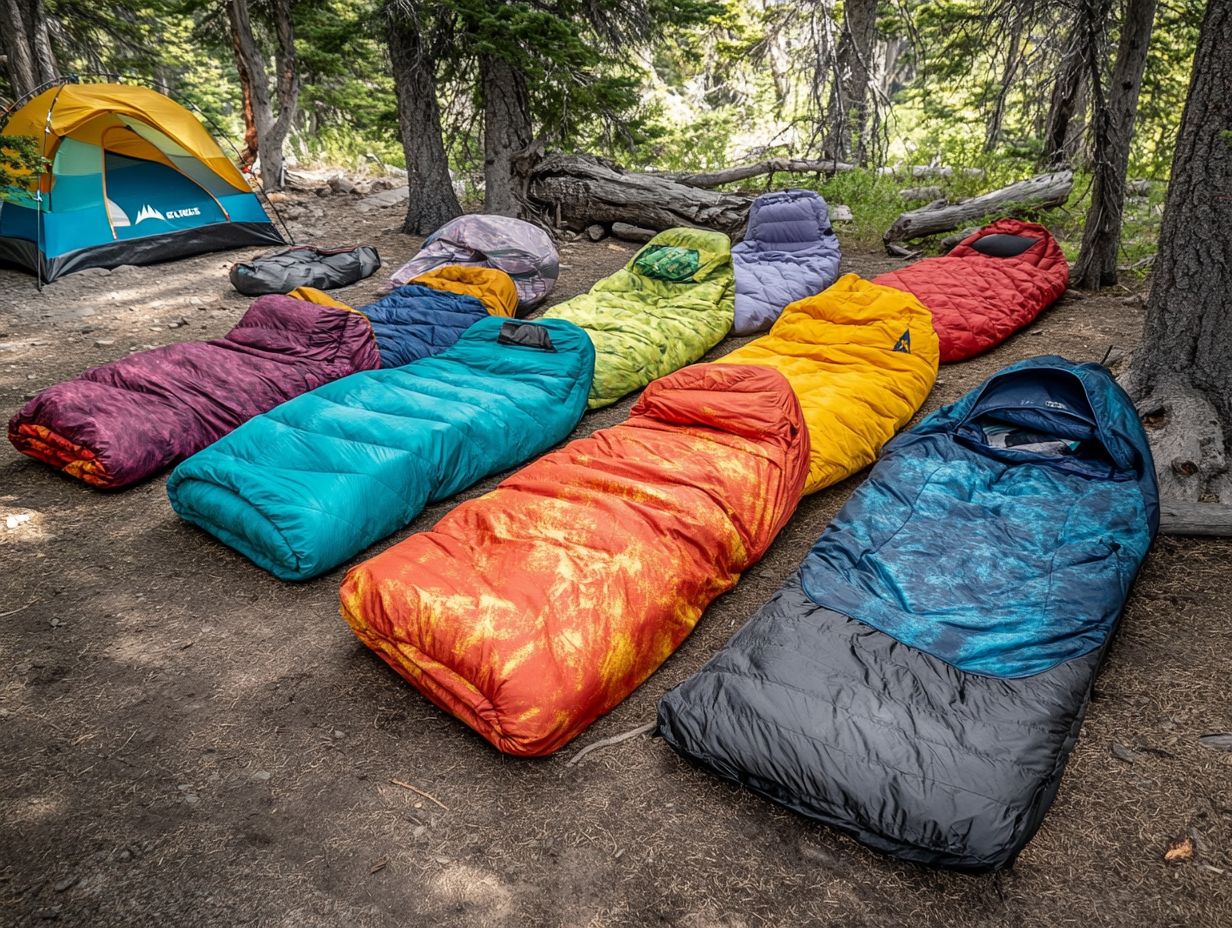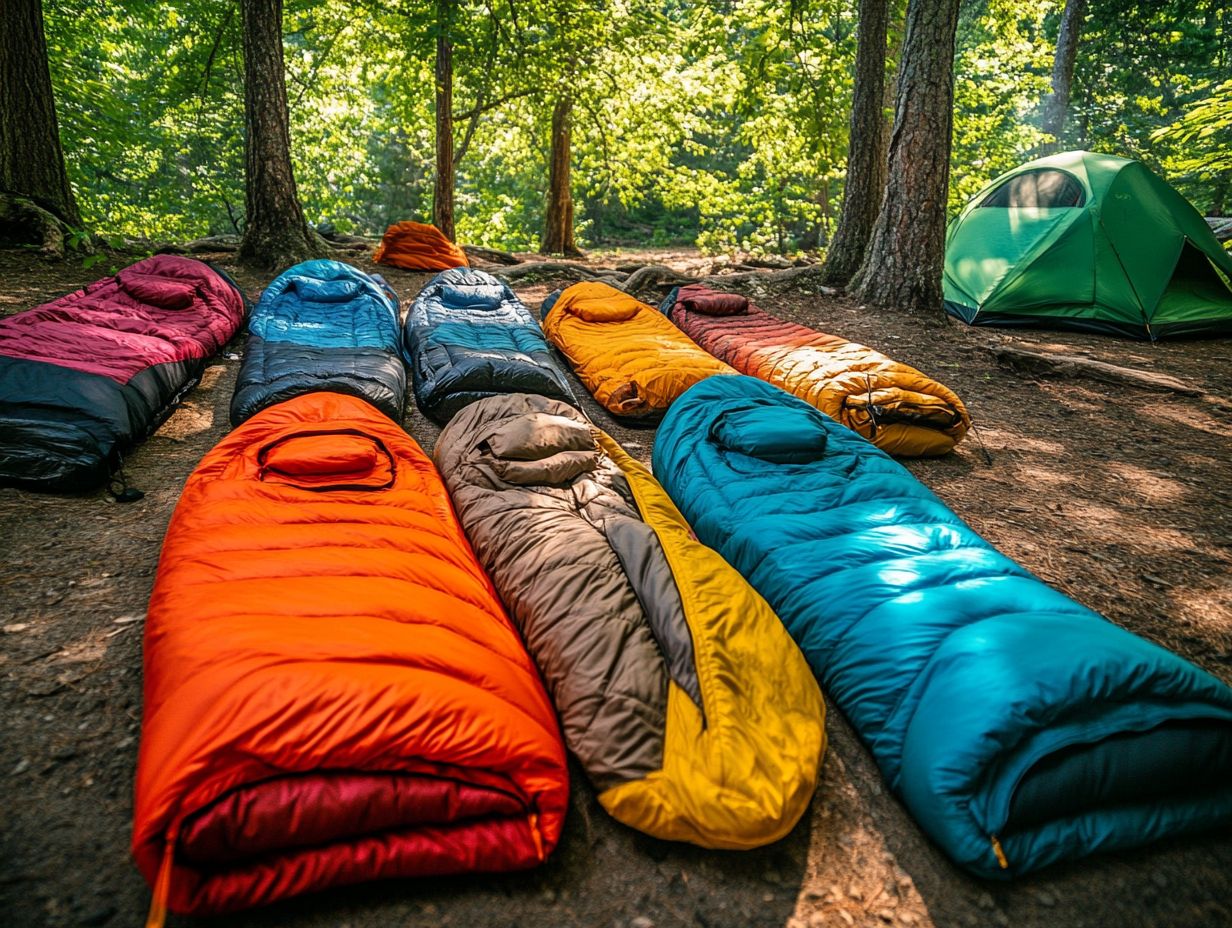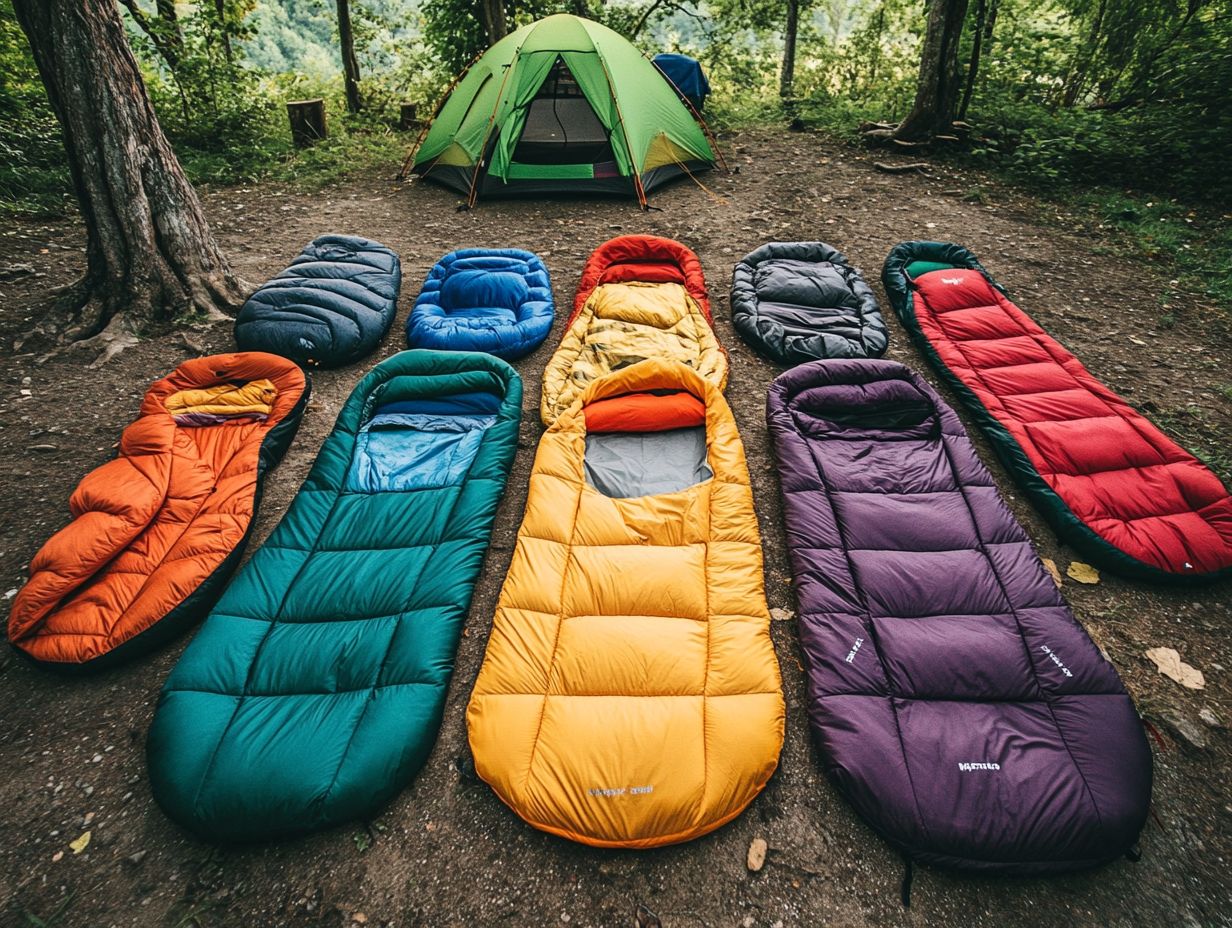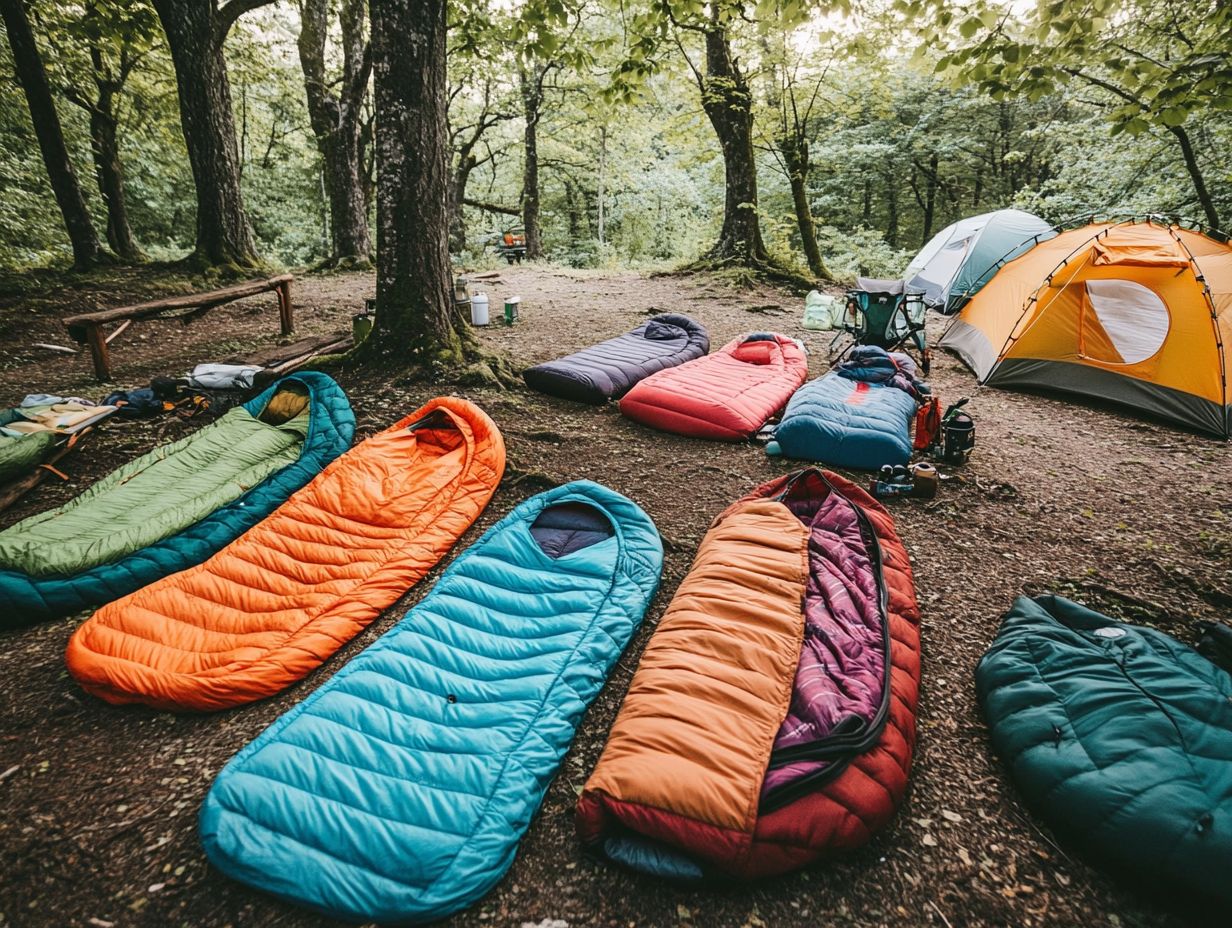How to Select a Sleeping Bag for Your Trip
When planning your next outdoor adventure, choosing the right sleeping bag can make the difference between a peaceful night under the stars and a night filled with discomfort.
With an array of types, sizes, and features to navigate, the world of sleeping bags can feel quite overwhelming.
This guide will walk you through the essentials. You will understand the various types and insulation options, select the right size and materials, and discover additional features that can elevate your camping experience.
We will also provide tips for maintaining your sleeping bag, ensuring it remains reliable for many trips ahead. Get ready to discover the perfect sleeping bag that will transform your outdoor adventure!
Contents
- Key Takeaways:
- Understanding Sleeping Bags
- Choosing the Right Size and Shape
- Insulation and Temperature Ratings
- Materials and Durability
- Additional Features to Look For
- Caring for Your Sleeping Bag
- Frequently Asked Questions
- What factors should I consider when selecting a sleeping bag for my trip?
- How do I determine the appropriate temperature rating for my sleeping bag?
- What is the best material for a sleeping bag?
- Does the shape of the sleeping bag matter?
- Can I use the same sleeping bag for different types of trips?
- Should I focus on weight or comfort when choosing a sleeping bag for my trip?
Key Takeaways:

- Choose the right type, size, and features of a sleeping bag for an enjoyable trip.
- Consider insulation and temperature ratings to find the perfect bag.
- Maintain and store your sleeping bag properly for long-lasting use.
Understanding Sleeping Bags
Understanding sleeping bags is crucial for anyone gearing up for a camping trip or outdoor adventure.
The right sleeping bag can dramatically elevate your comfort and warmth throughout the night.
Whether you’re in the market for a lightweight backpacking option or a more spacious rectangular bag for car camping, familiarizing yourself with the various types and features will empower you to make an informed decision.
Key factors include down insulation and synthetic insulation, temperature ratings, comfort ratings, and the bag s packability. These considerations can significantly enhance your outdoor experience, ensuring it’s enjoyable and restful.
Types of Sleeping Bags
You have a variety of sleeping bags at your fingertips, each tailored for specific conditions and preferences.
Take the mummy sleeping bag, for example. Its lightweight design makes it a favorite for backpackers.
Then there s the rectangular sleeping bag, which offers a spacious feel for those who value roominess.
Each style brings unique advantages suited to different adventures. Mummy sleeping bags, with their sleek, tapered shape, effectively trap heat, making them superb for cold-weather camping while keeping pack weight to a minimum.
Conversely, rectangular designs grant you plenty of space, allowing for easy movement and enhanced comfort, especially if you prioritize relaxation over shedding ounces.
It’s essential to grasp seasonal ratings as well. Summer sleeping bags are tailored for warm nights, while 3-season options strike a balance, making them versatile enough for spring, fall, and moderate winter conditions. Choosing the right type will undoubtedly elevate your overall outdoor experiences.
Key Features to Consider
When selecting a sleeping bag, it s essential to consider key features such as the temperature rating. This indicates how well the bag will perform in various weather conditions.
The comfort rating will give you a sense of how warm and cozy you can expect to feel while using it.
Understanding the different types of insulation is vital. If you prioritize lightweight and packable options, you may find yourself leaning toward down insulation, known for its impressive warmth-to-weight ratio.
Conversely, synthetic insulation offers excellent moisture resistance and tends to be more budget-friendly, though it can be bulkier.
Watch your weight limits when packing, particularly for extended trips, as this can significantly impact your overall gear load.
Pairing your sleeping bag with a suitable sleeping pad can greatly enhance your comfort and insulation. This ensures you enjoy a restful night, whether you re camping under the stars or navigating rugged trails.
Choosing the Right Size and Shape
Selecting the perfect size and shape of your sleeping bag is crucial for enjoying a restful night under the stars.
This choice can greatly influence your warmth and freedom of movement while you re nestled inside.
Consider your height and weight, the nature of your camping adventure, and whether you lean towards the cozy embrace of a mummy bag or the generous space of a rectangular one.
Being aware of your comfort limit will guide you in choosing a bag tailored to your unique needs across various seasons and environments.
Factors to Consider

When selecting a sleeping bag, several key factors come into play that can significantly enhance your overall experience. You’ll want to consider the comfort limit of the bag, which helps you understand the temperatures in which you’ll feel at ease, as well as the weight, which is essential for backpackers who need to save space.
These elements take on even greater importance depending on the type of trip you have in mind. If you’re venturing into the backcountry for extended hikes, a lightweight, compressible sleeping bag is essential for maintaining mobility and optimizing space in your pack. If you’re camping at established sites with a vehicle, consider a heavier, more insulated bag that offers extra warmth and a touch of luxury. For more guidance, check out what to consider when buying a sleeping bag.
By understanding how comfort limits correlate with the expected weather conditions, you can confidently choose the perfect bag for your adventure!
Insulation and Temperature Ratings
Insulation and temperature ratings are essential aspects of a sleeping bag’s performance, influencing how effectively it will keep you warm in diverse conditions.
Down insulation stands out for its lightweight and compressible nature, making it a top choice for backpacking enthusiasts. In contrast, synthetic insulation excels even in wet conditions, providing reliable performance when it matters most.
By familiarizing yourself with temperature ratings, such as ISO (International Organization for Standardization) and EN (European Norm) ratings, you can choose a bag that aligns perfectly with your anticipated outdoor environment, ensuring your comfort throughout your camping adventure.
Understanding Temperature Ratings
Temperature ratings play a vital role in helping you gauge the range of temperatures in which a sleeping bag can keep you comfortable, as well as the comfort rating that reflects how warm you’ll feel while using it.
These ratings are not pulled from thin air; they are the result of rigorous testing that considers factors like insulation type, bag shape, and even your personal metabolism. For outdoor enthusiasts like yourself, understanding both temperature and comfort ratings is essential since these metrics directly impact your sleep quality during camping trips.
A sleeping bag might hit a certain temperature threshold, but if the comfort rating doesn t align with your warmth preferences, you could find yourself tossing and turning all night. Thus, understanding how these ratings relate to your overall sleeping experience can significantly influence the success and enjoyment of your trip.
Mastering this knowledge gives you the power to make informed choices for your adventures, ensuring you wake up refreshed and ready for the day ahead!
Materials and Durability
The materials you choose for your sleeping bag play a crucial role in determining its durability, warmth, and overall performance. The outer fabric acts as a shield against the elements, while the inner lining enhances comfort and insulation.
Opting for high-quality materials not only boosts the longevity of your sleeping bag but also transforms it into a valuable investment for those who frequently camp or backpack.
Common Materials and Their Benefits
Common materials found in sleeping bags include down insulation, which provides an impressive warmth-to-weight ratio, and synthetic insulation, known for its durability and performance in wet conditions.
Each type of insulation offers distinct advantages. For instance, down is celebrated for its lightweight and compressible nature, making it a preferred choice for backpackers who value space and minimal weight. Conversely, synthetic materials, often crafted from polyester, shine in moisture resistance, managing to retain warmth even when damp.
The outer fabric of a sleeping bag is equally important. Durable water-repellent coatings protect the insulation from external elements, while breathable inner linings enhance comfort by effectively managing moisture and temperature regulation.
Together, these materials create a well-rounded sleeping bag that can endure various adventures, ensuring you enjoy a snug and restful sleep. Explore different materials based on your needs and get ready for incredible adventures!
Additional Features to Look For

When you re on the hunt for the perfect sleeping bag, it s crucial to think about those additional features that can elevate your comfort and convenience.
Consider compatibility with a sleeping pad and the option of using a sleeping bag liner. This helps provide extra warmth and keeps your bag clean. These details can make all the difference in your outdoor experience.
Useful Additions for Different Types of Trips
Depending on your trip, certain additions can enhance your experience. A sleeping bag liner offers extra warmth during chilly nights. Meanwhile, a sleeping pad improves insulation and comfort from the ground.
If you’re heading into colder climates, selecting the right sleeping bag liner is a game changer. It acts as your secret weapon for staying warm and helps maintain your sleeping bag’s cleanliness. If you are camping on rugged terrain, investing in a thicker sleeping pad is important, and knowing how to select the right sleeping pad for camping can truly transform your experience. It cushions your body against hard ground and minimizes heat loss, making your nights much more enjoyable.
Some prefer self-inflating pads for convenience and comfort, while others choose lightweight alternatives that are easier to pack. Knowing how to utilize these essentials will enhance your sleeping experience, tailored to the unique demands of each expedition.
Caring for Your Sleeping Bag
Caring for your sleeping bag is essential. It helps maintain its longevity and performance. Proper maintenance practices like regular cleaning and appropriate storage methods significantly preserve the integrity of the insulation and the outer fabric.
Tips for Proper Maintenance and Storage
To keep your sleeping bag in top-notch condition, follow essential maintenance and storage tips. Using a sleeping bag liner helps keep it clean, and avoiding compression during long-term storage is crucial.
That handy liner helps keep your sleeping bag clean. Make it a habit to inspect it regularly for any signs of wear or damage. Spot cleaning stains as soon as they happen prevents them from settling in. A gentle wash in cold water helps preserve the integrity of the materials.
When you’re not using it, stash the sleeping bag in a breathable, oversized storage sack. This allows it to maintain its loft without getting crammed.
Keep it out of direct sunlight. This protects the fabric and extends the lifespan of its insulation. By adopting these thoughtful practices, you ll ensure that your sleeping bag remains a reliable source of warmth and comfort for countless adventures ahead.
Frequently Asked Questions
What factors should I consider when selecting a sleeping bag for my trip?

Important factors to consider include:
- Temperature rating
- Weight
- Size
- Material
- Shape
How do I determine the appropriate temperature rating for my sleeping bag?
Consider the average temperature of the area you will be camping in. Choose a sleeping bag with a temperature rating a few degrees lower. Checking the weather forecast for your trip is also helpful.
What is the best material for a sleeping bag?
The best material depends on your personal preference and the conditions you will be camping in. Common materials include:
- Synthetic
- Down
- Hybrid blends
Does the shape of the sleeping bag matter?
Yes, the shape affects weight, insulation, and comfort. Common shapes are:
- Rectangular
- Mummy
- Semi-rectangular
Mummy bags provide more warmth and weight savings, while rectangular bags offer more room to move around.
Can I use the same sleeping bag for different types of trips?
Yes, it is possible, but consider the temperature rating and material for each trip. For varying temperatures or climates, a versatile sleeping bag with a wider temperature range and durable material may be a better choice.
Get ready for your next adventure choose your perfect sleeping bag today!
Should I focus on weight or comfort when choosing a sleeping bag for my trip?
Your choice depends on your preferences and how long you ll be traveling. If you re carrying the bag for a long time, weight is crucial.
On the other hand, if you want a comfy sleep, a slightly heavier bag might be worth it. Choose what feels best for your adventure!






